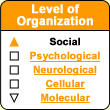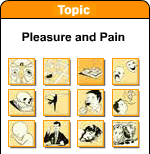| |



Humans
Have No Monopoly on Empathy
“When we get right down to it, what do
we human beings do all day long? We read the world, especially the people we encounter.
[...] When a colleague reaches for a wrench in the laboratory, I know he’s
going to work on the magnetic stimulation machine, and he’s not going to
throw his tool against the wall in anger. When another colleague walks in with
a grin or a smirk on her face—the line can be fine indeed, the product of
tiny differences in the way we set our face muscles—I automatically and
almost instantaneously can discern which it is. We all make dozens—hundreds—of
such distinctions every day. It is, quite literally, what we do. Nor do
we give any of this a second thought. It all seems so ordinary. However, it is
actually extraordinary—and extraordinary that it feels ordinary!”
- Marco Iacoboni, Mirroring People: The New Science of How We
Connect with Others, 2008. |
Humans are not the only mammals in whom seeing
a member of one’s own species suffer may trigger altruistic behaviours or
alter one’s own pain-perception threshold. In one set of experiments,
for example, rats who had learned to obtain food by pressing a lever would stop
pressing that lever if they saw that doing so also delivered an electric shock
to another rat whom they could see. The same holds true for rhesus monkeys.
One monkey who had learned to pull a chain to receive food refrained from doing
so for 5 days (and another for 12 days!) after realizing that pulling the chain
also gave another monkey an electrical shock. Yet another study showed
that when mice were placed together in the same cage and allowed to see another
mouse in pain, they became more sensitive to pain than when they were tested alone.
Thus a form of social contagion appears to exist among non-human mammals,
which confirms the important influence of social factors on the perception of
pain. |
| |
| SHARING OTHER PEOPLE’S PAIN | |
Because we humans
are such a social species, we spend a lot of our time trying to understand what
other people are feeling and what their intentions are toward us. Obviously, human
language, with its complex syntax
and its other,
non-verbal dimensions, is one of the main tools that we use to communicate
with one another about our states of mind. But
we also get much of our understanding of other people quite rapidly just by observing
their faces and posture. There are many conceivable evolutionary explanations
for this highly efficient means of communication. If someone else is in pain,
for example, the look of suffering on their face may tell us that there is some
potential danger to ourselves as well. That same look might also motivate us to
come to that person’s aid, a behaviour also seen in our primate cousins,
and even in rats (see sidebar). Evolutionary
advantages such as these make it more understandable why we can so easily read
what is going on in other people’s minds. But what mechanisms do we
use to do so? In other words, how does someone else’s emotional condition
get reflected in our own neural substrate? At
a first level of analysis, many studies have shown that simply looking at someone
else’s facial expression causes us to adopt a similar facial expression,
often without even realizing it. Thus, underlying our social interactions and
our shared emotions, there seems to be a mimicry that is usually unconscious and
automatic. And this direct linkage between our perceptions and our actions makes
us “resonate” with the person whom we are observing, whether we want
to or not. Other studies have shown the
very real psychological effects that such a resonance can have. For example, people
who observe other people being disgusted by a bad smell will experience a sense
of disgust themselves. And we all know how unpleasant it is to see someone else
cut themselves badly with a sharp blade. Around
the year 2000, brain-imaging studies began to show that when we see someone else
who is disgusted or in pain, it activates, in our own brains, certain parts of
the neural network that is normally active when we are actually experiencing disgust
or pain ourselves. Around this same same time,
the gradual discovery of the existence of mirror
neurons opened new avenues to study what many neuroscientists now refer to
as our “shared
neural networks”. Because mirror neurons are activated both when we
make a certain movement ourselves and when we see someone else make it, researchers
came to regard them as a highly likely substrate for this sharing process. To
give some shape to these findings on the sharing of emotions, a scientific “theory
of simulation” was developed that incorporated the role of mirror neurons.
But to discuss this theory in a rigorous way, we must first define, as clearly
as possible, some of the terms that we may associate with the sharing of emotions—terms
such as empathy, sympathy, and compassion.


| | Empathy
can be defined in everyday language as the ability to “put yourself
in someone else’s skin”. Because this word is used in many different
disciplines (psychology, sociology, and philosophy, to name but a few), it can
be defined in several other ways as well. But most of these definitions share
an emphasis on the ability to feel another person’s affective states or
their sensations (including pain). Empathy is thus distinguished from the
ability to adopt someone else’s perspective so as to understand their intentions,
desires, and beliefs. Many cognitive scientists see that process as one of reasoning
and hence different from an empathic response. Nor does the emotional sharing
involved in empathy necessarily imply that the person who is experiencing it will
act or even feel moved to act to support the person for whom the empathy is being
experienced. This is precisely what distinguishes empathy from sympathy,
in which the person who is experiencing it also feels a positive attitude
or altruistic motivation toward the person in question. | Compassion
closely resembles sympathy but is more specifically associated with pain, arousing
a strong desire to relieve another person’s suffering. Along similar but
broader lines, caring
may be defined as affectionate and unconditional attention that we give to someone.
Pity too involves the desire to alleviate someone else’s
suffering, but also entails the sometimes condescending belief that they could
not deal with it on their own. Empathy
is also different from emotional contagion,
a process in which one person catches and feels another’s affective state
without realizing that this emotion is not really his or her own. Good examples
of emotional contagion include the excitement rising among fans in a football
stadium, or panic spreading through a crowd, or laughter spreading through an
audience. In contrast, when people experience empathy, they are fully aware that
the emotion that they are experiencing comes from observing someone else. |
|






